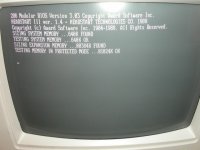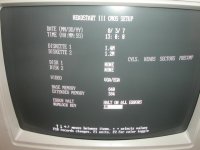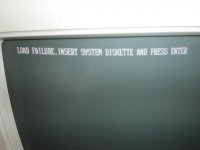Aristocrat
New Member
- Joined
- Aug 22, 2007
- Messages
- 5
Hi, I'm hoping you guys might be able to assist me in getting an old Vendex Headstart III I have up and running. I'm pretty proficient with Windows, but when it comes to DOS and BIOS kinds of issues I'm a bit of a novice.
The computer worked a few years ago, but apparently the BIOS battery died. I replaced that, but I'm not sure what needs to be done now, becuase I still can't boot up properly.
I have the original master disk set, and I checked to see what kinds of files were currently on them. It appears they contain all the original data.
Here's what happens when I power up:
Bios screen and memory testing (1st attached pic)
Pressing delete gives me a keyboard error and suggests pressing ctrl+alt+esc to enter setup.
If I do that, then I get to Headstart III CMOS Setup. (2nd attached pic) Is everything okay here?
Then no matter what I do, I get "load failure, insert system diskette and press enter." (3rd attached pic)
Unfortunately inserting the system floppy disk and pressing enter doesn't help. It tries to read the disk, then just comes back to the same screen.
Here are the contents of the first master disk:

Thanks in advance for your help and consideration.
The computer worked a few years ago, but apparently the BIOS battery died. I replaced that, but I'm not sure what needs to be done now, becuase I still can't boot up properly.
I have the original master disk set, and I checked to see what kinds of files were currently on them. It appears they contain all the original data.
Here's what happens when I power up:
Bios screen and memory testing (1st attached pic)
Pressing delete gives me a keyboard error and suggests pressing ctrl+alt+esc to enter setup.
If I do that, then I get to Headstart III CMOS Setup. (2nd attached pic) Is everything okay here?
Then no matter what I do, I get "load failure, insert system diskette and press enter." (3rd attached pic)
Unfortunately inserting the system floppy disk and pressing enter doesn't help. It tries to read the disk, then just comes back to the same screen.
Here are the contents of the first master disk:

Thanks in advance for your help and consideration.





